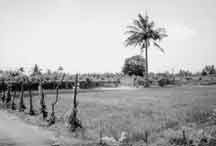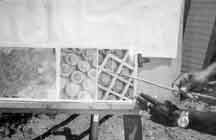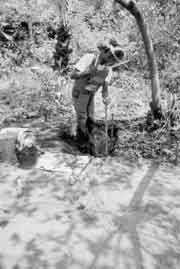|
DAILY NEWS ONLINE |
|
|
|
OTHER EDITIONS |
|
|
|
|
|
|
|
|
|
OTHER LINKS |
|
|
|
|
|
|
 |
Jaffna bristling with 900,000 landmines, but mine clearing makes progress
The Halo Trust - the British landmine clearing organisation in the North - has cleared over 38,000 mines in Jaffna over the last three years. Yet the estimated number of landmines in Jaffna and Kilinochchi districts is around 900,000. These landmines were laid by both the LTTE and the Sri Lanka Army (SLA) to protect military bases and defensive areas during the conflict. "Demining will have to continue for several more years in Jaffna but anything can change with more donor funding," Ed Rowe, Program Manager and head, Halo Trust Sri Lanka told the Daily News. Rowe has been with the project since last March. Initially, in 2003 the team set a target to make Jaffna mine free by 2006 - provided they doubled or trebled the capacity. However, considering the present situation, this target cannot be achieved due to various reasons.
Under this project, Rowe said that they have already trained a large number of local people to identify, delineate, demarcate and clear contaminated land to international standards. Having completed the training phase, the team will implement activities in order to hand over safe land to the local community and ensure the safe return of IDPs to their former homes. "Through this project we want to ensure the safe return of the war-displaced population to their areas of origin and therefore contribute to the economic recovery and reconstruction of the Northern and Eastern provinces," Rowe said. The areas which have already been cleared have recorded an improved number of returnees. Many have restarted farming and some of the mine cleared areas we visited, were thriving with new farming beds of vegetables, spring onions and grapes. "We will continue to conduct technical surveys of suspected areas to reduce the size of the problem, we will continue to focus on the Jaffna Government Agent's "High Priority" sites and we will continue to ask donors for more funding to increase our demining capacity so we can clear the problem quicker.
Although there are many thousands of mines in Sri Lanka, the overwhelming majority were laid very close together in narrow, well-defined rows. Most of them have now been marked, and the population which is returning to their former homes is being made aware of the mine threat. Rowe said that Sri Lanka Army has followed the British mine line tactics, in creating their defence lines and Army mine maps have been given to Halo Trust. "And that has made it easy for us to carry out the demining process. However, the LTTE mine fields are ad-hoc and it is difficult to locate their mine fields," he said. Referring to the mine clearing process Rowe said they cannot use modern detects and machinery in certain areas as Jaffna's soil is very fertile and contains a lot of minerals. "We don't want to destroy the natural resources," he said.
In certain areas people live very near landmine fields. Some people clear landmines on their own while some others ask us to clear their lands, he said. At the same time people who demine throw them in the lands of their rivals. This is a dangerous situation. "Sometimes people take the sticks which we use as mine signs to delineate the boundaries between safe and contaminated land, for firewood, he said. We visited Irupulathrai - a semi-residential farming area, where we met Pakiyam, a 72-year old woman who had returned to her native village after the truce. Although there is no fighting after the truce, she is unhappy that she doesn't have a house to live in. A mother of three children, Pakiyam's house got damaged during the conflict, she told us.
We also met a farmer - Dharmalingam (45), near a cleared mine field where his house was. He says things are quite normal after the ceasefire agreement. But the landmines are posing a threat and they should be removed at the earliest.
Following are excerpts of Rowe's interview: Question: What are Halo Trust predictions about the magnitude of the number of mines in Jaffna? Answer: Following the initial survey of all minefields in Jaffna in 2002, it was estimated that the worst affected areas outside the High Security Zones (HSZ) were the districts of Jaffna and Kilinochchi where an estimated 900,000 landmines had been laid. In the last three years, The Halo Trust has cleared over 38,000 mines from Jaffna. Question: Can you explain the present funding situation - and how you plan to raise more funds through donor agencies for this endeavour? Answer: The funding for all mine action organisations in Sri Lanka is limited for a number of political reasons. Every year, we have to push donors to continue another year of funding and the only thing we can do is to keep knocking on the donors doors asking for funding for mine clearance. We need to educate the donor community and show them that the only way for Jaffna to get back on its feet again is to remove the landmines. Once the landmines have been removed, houses can be repaired or built, people can return, children can play safely, schools can be rebuilt and the land can be developed again for agricultural crops or dairy production. Jaffna is an amazingly beautiful place with diverse cultures and very friendly people. The soil is extremely fertile and with the landmines removed, thousands of families could benefit from a living on the land. Question: Is there any possibility to increase the organisational capacity by two or three fold as planned at the initial stage? Can it happen in the future? Answer: It is extremely unlikely that we will double in capacity through donor funding. The only way to speed up the clearance process is to employ more manual deminers to physically clear the mines from the ground. Our current donors have been fantastic, they take a great interest in our work and visit the program regularly. Our two biggest donors at present are ECHO and the Government of Japan with several other sections funded by DFID, The Government of Switzerland and the Government of Finland. Question: In your opinion how long will it take to fairly assure the safety of people? Answer: Halo has conducted its operations in Government held areas in furtherance of the Government's aim to clear all mines from areas under their control, less those within the HSZ, by the end of 2006. Expansion of capacity (amongst all agencies) has been slower than anticipated and the Government has now accepted that the original goal is not achievable within that time frame. To its credit, the Government is shifting towards an 'end state' strategy rather than an 'end date' strategy. At present the end state the Government is aiming for its 'mine free' but this may be reduced to 'impact free' in due course. However, it is impossible for anyone to give an end date to clearing the problem. It's obvious that the date originally set for the end of 2006 is not going to be achieved. We will continue to conduct technical surveys of suspect areas to reduce the size of the problem, we will continue to focus on the Jaffna Government Agent's "High Priority" sites and we will continue to ask donors for more funding to increase our demining capacity so we can clear the problem quicker. Question: How do you explain the cooperation you have received so far from the LTTE? Answer: The LTTE have been extremely cooperative over the last 3 years and have always assisted Halo in Jaffna. We are a neutral, non-government, non-political charity and we take time to explain Halo's plans to both sides. We have always received warm support from the SLA and LTTE for the work we carry out and I intend to keep this good relationship with them. Land mine accidents
|
||||||
|
|





